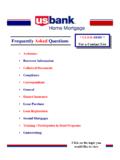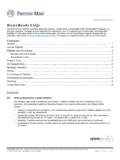Transcription of Trade Credit Insurance - World Bank
1 Trade Credit Insurance Peter M. Jones primer series on Insurance issue 15, february 2010. non- bank financial institutions group global capital markets development department financial and private sector development vice presidency Trade Credit Insurance Peter M. Jones primer series on Insurance issue 15, february 2010. non- bank financial institutions group global capital markets development department financial and private sector development vice presidency ii Risk Based Supervision THIS ISSUE. Author Peter M. Jones was the Chief Executive Officer of the African Trade Insurance Agency (ATI) from 1 February, 2006 up until 31 July, 2009 when he retired. During his time as CEO of ATI, Peter successfully implemented a legal and capital restructuring, including the expansion of the Agency's product offering to ensure that it meets the full needs of the private and public sector in Africa.
2 Prior to joining ATI, Peter held various positions at the Multilateral Investment Guarantee Agency (MIGA). He was also a Vice-President at Export Development Canada (EDC), where he was responsible for all of EDC's business operations in the Transportation sector, as well as for the establishment, development and management of its equity investment program. This experience, together with his senior positions at the Canadian Imperial bank of Commerce (CIBC) and ANZ/Grindlays bank , has provided him with wide ranging skills and experience in identification of viable equity opportunities, including successful exits. Peter is a Fellow of the Institute of Chartered Secretaries and Administrators.
3 Series editor Rodolfo Wehrhahn is a senior Insurance specialist at the World bank . He joined the bank in 2008 after 15 years in the private reinsurance and Insurance sector and 10 years in academic research. Before joining the World bank , he served as President of the Federation of the Interamerican Insurance Associations representing the American Council of Life Insurers. He was board member of the AEGON Insurance and Pension Companies in Mexico, and was CEO of reinsurance operations for Latin America for Munich Reinsurance and for AEGON. For questions about this primer, or to request additional copies, please contact: The Primer Series on Insurance provides a summary overview of how the Insurance industry works, the main challenges of supervision, and key product areas.
4 The series is intended for policymakers, governmental officials, and financial sector generalists who are involved with the Insurance sector. The monthly primer series, launched in February 2009 by the World bank 's Insurance Program, is written in a straightforward, non-technical style to share concepts and lessons about Insurance with a broad community of non-specialists. The Non- bank Financial Institutions Group in the Global Capital Markets Development Department aims to promote the healthy development of Insurance , housing finance, and pension markets, and to expand access to a broad spectrum of financial services among the poor. These markets provide opportunities for household investment and long-term savings, and can buffer the poor against the risks of sickness, loss of breadwinner, catastrophic events, and other misfortunes.
5 2009 The International bank for Reconstruction and Development/The World bank 1818 H Street, NW. Washington, DC 20433. Internet: E-mail: All rights reserved. First printing June 2009. This volume is a product of the staff of the International bank for Reconstruction and Development/The World bank . The findings, interpretations, and conclusions expressed in this paper do not necessarily reflect the views of the Executive Directors of The World bank or the governments they represent. The World bank does not guarantee the accuracy of the data included in this work. The boundaries, colors, de- nominations, and other information shown on any map in this work do not imply any judgement on the part of The World bank concerning the legal status of any territory or the endorsement or acceptance of such boundaries.
6 Cover and publication design: James E. Quigley Cover illustration: Imagezoo/Corbis Contents 1. 3. 3. What is Trade Credit Insurance ?.. 6. What are the Benefits of Trade Credit Insurance ?.. 9. Should a Supplier Purchase Trade Credit Insurance ?.. 10. How Does a Trade Credit Insurance Policy Work?.. 11. 12. Alternative 13. Letters of 13. 14. The Credit Insurance 14. Is Trade Credit Insurance for Everyone?.. 16. 17. Annex 1 Some frequently asked questions and 19. Annex 2 Glossary of terms used in Trade Credit 27. iii Introduction The sales of goods and services are exposed to a significant number of risks, many of which are not within the control of the supplier. The highest of these risks and one that can have a catastrophic impact on the viability of a supplier, is the failure of a buyer to pay for the goods or services it has purchased.
7 In today's challenged domestic and global economic climate, recog- nizing and managing future risks has become a priority for businesses. Losses attributed to non-payment of a Trade debt or bankruptcy can and do occur regularly. Default rates vary by industry and country from year-to-year, and no industry or company is immune from Trade Credit risk. Trade Credit risk Insurance is an Insurance policy and a risk management product offered by private Insurance companies and governmental export Credit agencies to business entities wishing to protect their accounts receivable from loss due to Credit risks, such as protracted default, insolvency, bankruptcy, etc. This Insurance product, commonly referred to as Trade Credit Insurance , is a type of property and casualty Insurance and should not be confused with such products as Credit life or Credit disability Insurance , which the insured obtains to protect against the risk of loss of income needed to pay debts.
8 Trade Credit Insurance can also include a component of political risk insur- ance, which is offered by the same insurers to insure the risk of non- payment by foreign buyers due to the actions or inactions of the buyer's government. This leads to the major role that Trade Credit Insurance plays in facilitating domestic and international Trade . Trade Credit is offered by 1. 2 Trade Credit Insurance suppliers to their customers as an alternative to pre-payment or cash on delivery terms, or the need for expensive bank letters of Credit , providing time for the customer to generate income from sales before paying for the product or service. This requires the supplier to assume non-payment risk.
9 In a local or domestic situation, as well as in a cross- border or export transaction, the risk increases when laws, customs, communications and customer's reputation are not fully understood by the supplier. In addition to increased risk of non-payment, interna- tional Trade presents the problem of the time between product ship- ment and its availability for sale. The account receivable is like a loan and represents capital invested, and often borrowed, by the supplier. But this is not a secure asset until it is has been paid. If the customer's debt is Credit insured the large, risky asset becomes more secure, like an insured building. This asset may then be viewed as collateral by lending institutions and a loan based upon it may be used to defray the expenses of the transaction and to fund the production of more goods or supply of more services.
10 Trade Credit Insurance thus enables suppliers to significantly increase their overall sales turnover, reduce Credit risk related losses and improve the profitability of their business. At the macroeconomic level, Trade Credit Insurance helps to facilitate international Trade flows and contributes to the global economic growth, allowing transactions to occur that would otherwise have been too risky. It also enhances economic stability by sharing the risks of Trade losses with the Trade Credit insurers, who are better equipped to absorb them. In the absence of Trade Credit Insurance , and in order to avoid Credit risk related losses, suppliers would have no choice but to rely on either full pre-payment for goods and services by buyers or to seek a third party which is willing to take the Credit risk for a price.













